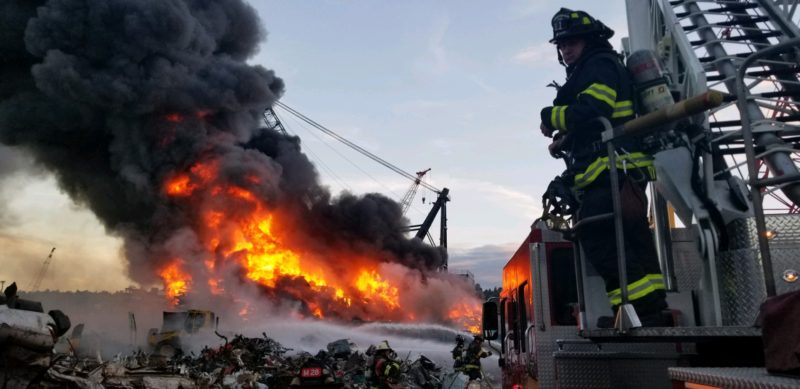A series of barge fires since May involving crushed cars demonstrated the danger to mariners handling those cargoes, when firefighters faced toxic smoke and exploding fuel.
Another fire ignited June 24 on the Mississippi River in Jefferson Parish, La., again in a load of junked cars on a Sunday in a fleeting area. The fire blanketed nearby Old Jefferson with choking smoke on a sweltering hot day, and firefighters had to use so much water the barge was for a time in danger of sinking.
Two days later a barge load of scrapped cars erupted on the Duwamish River in Seattle, a spectacular blaze in a stack 30’ high that included the additional danger of exploding propane bottles mixed in with the junk.
It was a both a firefighting and hazardous-materials challenge for the Seattle Fire Department, which has long experience with maritime fire dangers and some of the most stringent waterfront regulations in the nation to manage that risk.
The first SFD responders laid hose lines from pumper trucks to attack the fire, and were joined by a foam truck from the Seattle-Tacoma International Airport. They kept the fire contained until the arrival of an SFD fireboat, the 108’x26’x10’ Leschi, which finally got it under control.
“The (terminal) crane operator picked up chunks of cars so the water and foam could get to all of the hot spots,” said Lt. Sue Stenger, a department spokeswoman.
Two Seattle firefighters had to be treated for minor injuries from exhaustion fighting the blaze, and no other serious injuries were reported in the Louisiana and Alabama fires. But the coincidence points up an underappreciated hazard in the recycling industry.

A Seattle fireboat attacks the June 26 barge fire. SFD photo
After their initial processing crushed cars can still hold plenty of residuals that will fuel a fire, said Lawrence Russell, a principal specialist with the National Fire Protection Association, Quincy, Mass.
“Everything from seat cushions to plastics,” said Russell. “Is there still some gasoline in there, is it diesel? These things get crushed, the containers get ruptured.”
If recyclers have missed a few old batteries in the load, they can give off flammable hydrogen gas, or be ignition sources themselves.
With the fuel available, “it may be as simple as someone smoking a cigarette, flicking a butt,” Russell said. “It could be someone doing hot work,” welding or cutting metal, he added. “Depending on the conditions even grinding can be considered hot work.”
Seattle is “one of the few municipalities that have strict rules on hot work in marine waterfront areas,” he said.
The city developed those regulations in reaction to a series of vessel fires, notably the Omnisea incident in 1991 when a 324’ fish processor undergoing refit caught fire from a cutting and welding operation.

A 1991 fire on the fish processing vessel Omnisea was one factor in shaping Seattle's strict marine fire prevention policy. NOAA photo
“They were doing hot work and decided to take a break, and the fire watch took a break with them,” recalled Capt. Roger Sargent of the SFD fire marshal’s office. “When they came back after 15 minutes there was a pretty good fire going.”
The resulting five-alarm fire brought in 65 units from Seattle and surrounding towns. The SFD marine unit devised a strategy to attack the Omnisea fire using carbon dioxide, but it was difficult to get the ship’s openings tight enough to contain the gas. It took 10 truckloads of carbon dioxide and almost a week to ensure the fire was completely out.
Under Seattle’s permitting system today, a certified “shipyard-competent person” must be on site to supervise hot work.
“Anywhere in the city, if you’re working on a marine vessel you need a temporary hot work permit, with very few exceptions,” said Terry Williams, a firefighter inspector with the SFD fire prevention division. That includes cutting, welding, soldering, brazing and grinding, except for some maintenance work like abrasive blasting or needle gunning on deck.
About 10% of permits call for a stricter level of supervision for work below deck, in machinery and oily compartments and adjacent spaces, and in tank vessels, when marine chemists are required to assess a work plan, said Williams.
Other rules specify when and how hose lines must be laid out and charged in preparation for doing hot work. SFD inspectors pay particular attention to the dangers of igniting foam insulation – common around fish holds, for example.
In all cases exposed foam must be wetted or covered with welding cloth, and the insulation removed with 36” of where the hot work is being performed. That raises eyebrows among some vessel operators, but the rule reflects the department’s experience, said Williams.
“It’s time consuming and labor intensive,” he acknowledged. “We respect foam, and know how it can burn.”





